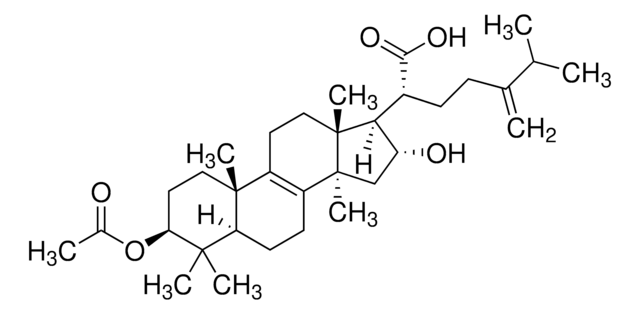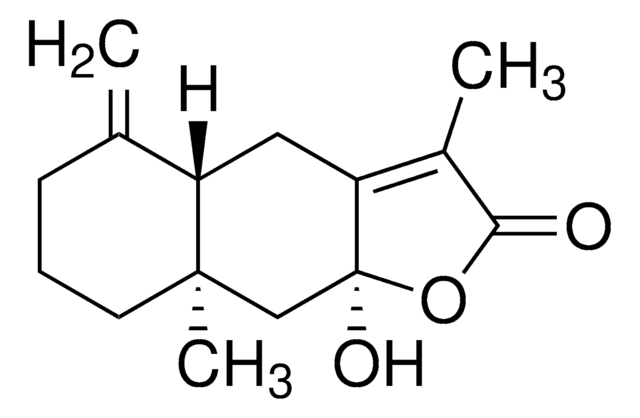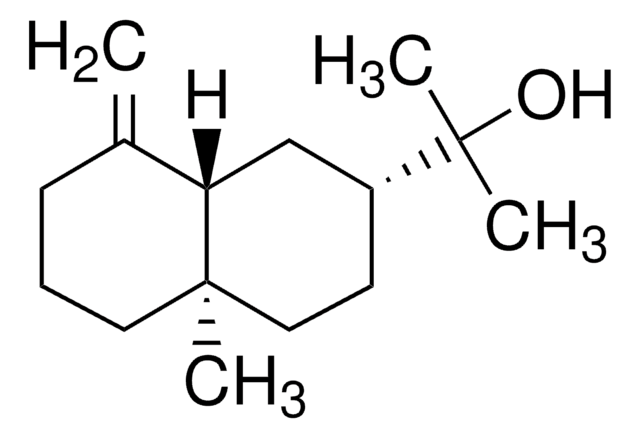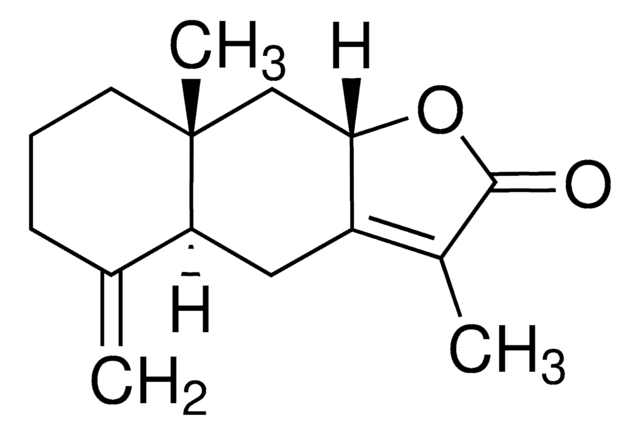推薦產品
品質等級
化驗
≥98% (HPLC)
形狀
powder or crystals
溶解度
methanol: 1 mg/mL, clear, colorless
應用
metabolomics
vitamins, nutraceuticals, and natural products
儲存溫度
2-8°C
SMILES 字串
C=C1CCC[C@@](C=C2O3)(C)[C@@]1([H])CC2=C(C)C3=O
InChI
1S/C15H18O2/c1-9-5-4-6-15(3)8-13-11(7-12(9)15)10(2)14(16)17-13/h8,12H,1,4-7H2,2-3H3/t12-,15+/m0/s1
InChI 密鑰
ZTVSGQPHMUYCRS-SWLSCSKDSA-N
尋找類似的產品? 前往 產品比較指南
一般說明
Atractylenolide I is one of the active ingredients of Rhizoma Atractylodes macrocephala which is obtained from the dried root and stem of Atractylodes Macrocephala Koidz. It is a sesquiterpene compound of hydrophobic nature.
應用
Atractylenolide I is a phytochemical that may be used to study its anti-inflammatory and anti-angiogenesis activities. Atractylenolide I may be used and studied as a postitive modulator of GABA-induced chloride currents I(GABA) and as an inhibitor of aromatases. Atractylenolide I may be used as a reference material in assays to detect its presence in plant root extracts and biological milieu such as plasma.
生化/生理作用
Atractylenolide I has been reported to have an anti-inflammatory activity due to its inhibitory effect on tumor necrosis factor-α (TNF-α) and the production of nitric oxide (NO). It also shows anti-cancer nature, thereby being used in the management of gastric cancer cachexia symptoms. Additionally, it has anti-angiogenic, pro-oxidative and cytotoxic characteristics.
Phytochemical from Traditional Chinese Medicine herbal preparations. Atractylenolide I is an anti-inflammatory that is reported to inhibit angiogenesis.
儲存類別代碼
11 - Combustible Solids
水污染物質分類(WGK)
WGK 3
閃點(°F)
339.6 °F
閃點(°C)
170.87 °C
分析證明 (COA)
輸入產品批次/批號來搜索 分析證明 (COA)。在產品’s標籤上找到批次和批號,寫有 ‘Lot’或‘Batch’.。
Hyun Young Park et al.
Planta medica, 77(13), 1528-1530 (2011-02-25)
The roots of Cyathula officinalis Kuan are widely used in Chinese medicine for the treatment of inflammatory disorders. Here, the ability of C. officinalis Kuan to downregulate matrix metalloproteinase (MMP)-13 was examined since MMP-13 is an important enzyme for the
Judith Singhuber et al.
Phytomedicine : international journal of phytotherapy and phytopharmacology, 19(3-4), 334-340 (2011-11-29)
Several Chinese herbal medicines (CHMs) are used in the treatment of insomnia, restlessness, or anxiety. However, mechanisms underlying this effect and scientific proof for their traditional use is scarce. In the present study CHMs were screened for their ability to
Yi Liu et al.
Evidence-based complementary and alternative medicine : eCAM, 5(3), 337-344 (2008-10-03)
We determined the therapeutic efficacy of atractylenolide I (ATR), extracted from largehead atractylodes rhizome, in managing gastric cancer cachexia (GCC), and interpreted its probable pharmacological mechanism via investigating tumor necrosis factor alpha (TNF-alpha), interleukin-1 (IL-1), interleukin-6 (IL-6) and proteolysis-inducing factor
Ching-Chiung Wang et al.
Food and chemical toxicology : an international journal published for the British Industrial Biological Research Association, 44(8), 1308-1315 (2006-04-21)
The dried rhizome of Bai Zhu (Atractylodes ovata) is widely used as a Chinese herbal medicine. Two sesquiterpenolides of similar structures (atractylenolide I, AT-I; atractylenolide III, AT-III) were isolated from dried rhizome of Atractylodes ovata. Incubation of AT-I with recombinant
Jian-Ming Huang et al.
Scientific reports, 4, 3840-3840 (2014-01-24)
Paclitaxel, a known TLR4 ligand, leads to activation of TLR4/MyD88-dependent pathway that mediates chemoresistance and tumor progression in epithelial ovarian carcinoma (EOC). Atractylenolide-I (AO-I), a novel TLR4-antagonizing agent, inhibits TLR4 signaling by interfering with the binding of LPS or paclitaxel
我們的科學家團隊在所有研究領域都有豐富的經驗,包括生命科學、材料科學、化學合成、色譜、分析等.
聯絡技術服務








